Back to Home
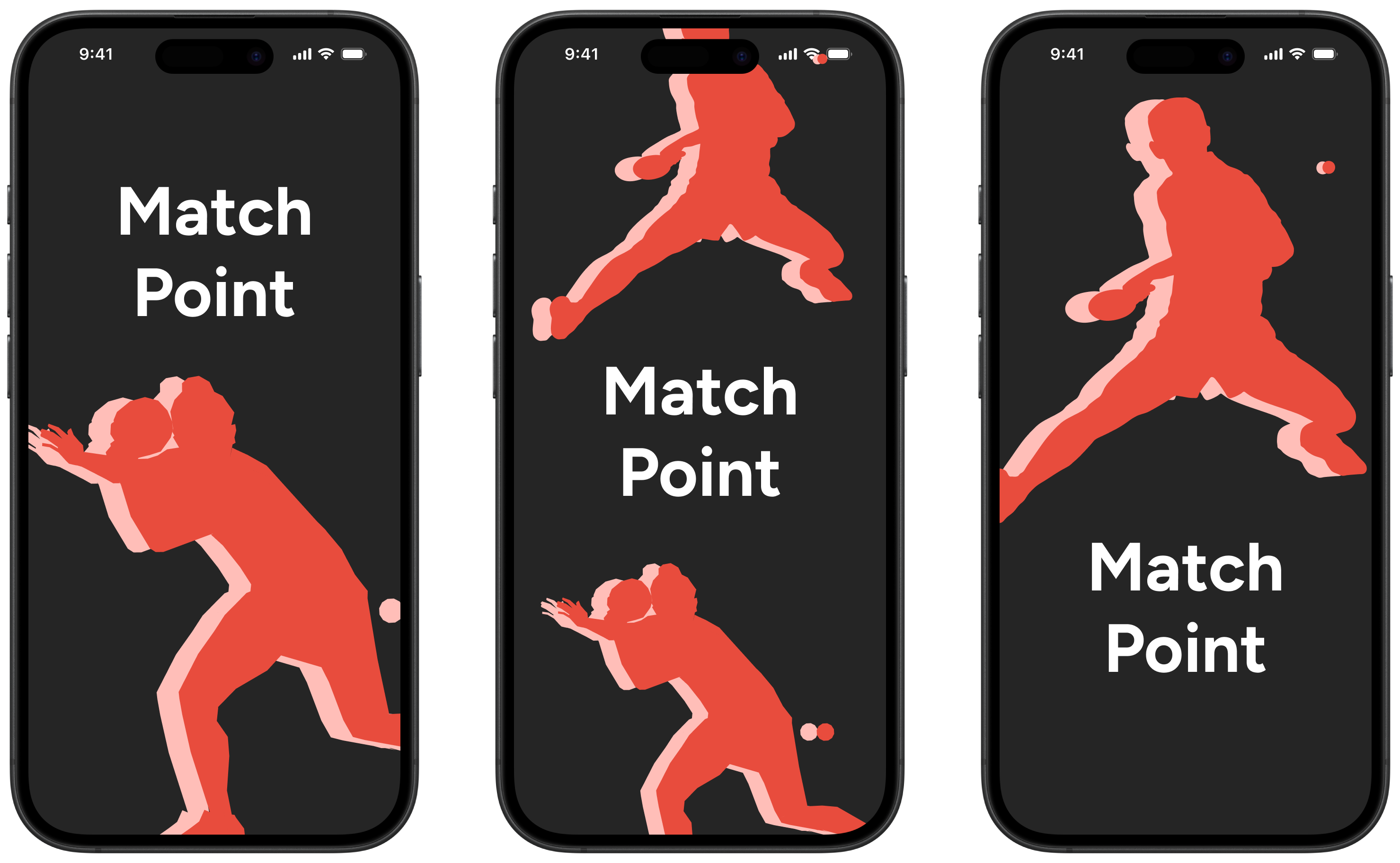
Match Point
Helping Local Table Tennis Players
Access and understanding of table tennis equipment is extremely difficult for up and coming players who don’t have the resources, knowledge, or coaches to help them.
Match Point is a tool that helps newer table tennis players discover equipment tailored to their individual play style, skill level, and goals. Using AI and natural language, players take a short quiz and optional refinement questions and receive gear recommendations that reflect how they actually play, not just how others review equipment online.
By giving players clear, transparent reasons behind each recommendation, Match Point turns a traditionally confusing, subjective process into one that’s simple, personal, and actionable.
See Final Designs
Use the Equipment Recommender GPT
Community Outcomes
High Accuracy
most test cases used in the questionnaire accurately recommended equipment to player archetypes, validated by seasoned professionals and players.
Usage of Recommendations
5 out of 6 players at the local club who used the tool continue to use setups recommended to them.
My Role
Designer & Creator, 2025
Collaboration
Partnered with players and table tennis clubs across the country to validate these recommendations.
Scope
UI Design, Custom ChatGPT Questionnaire
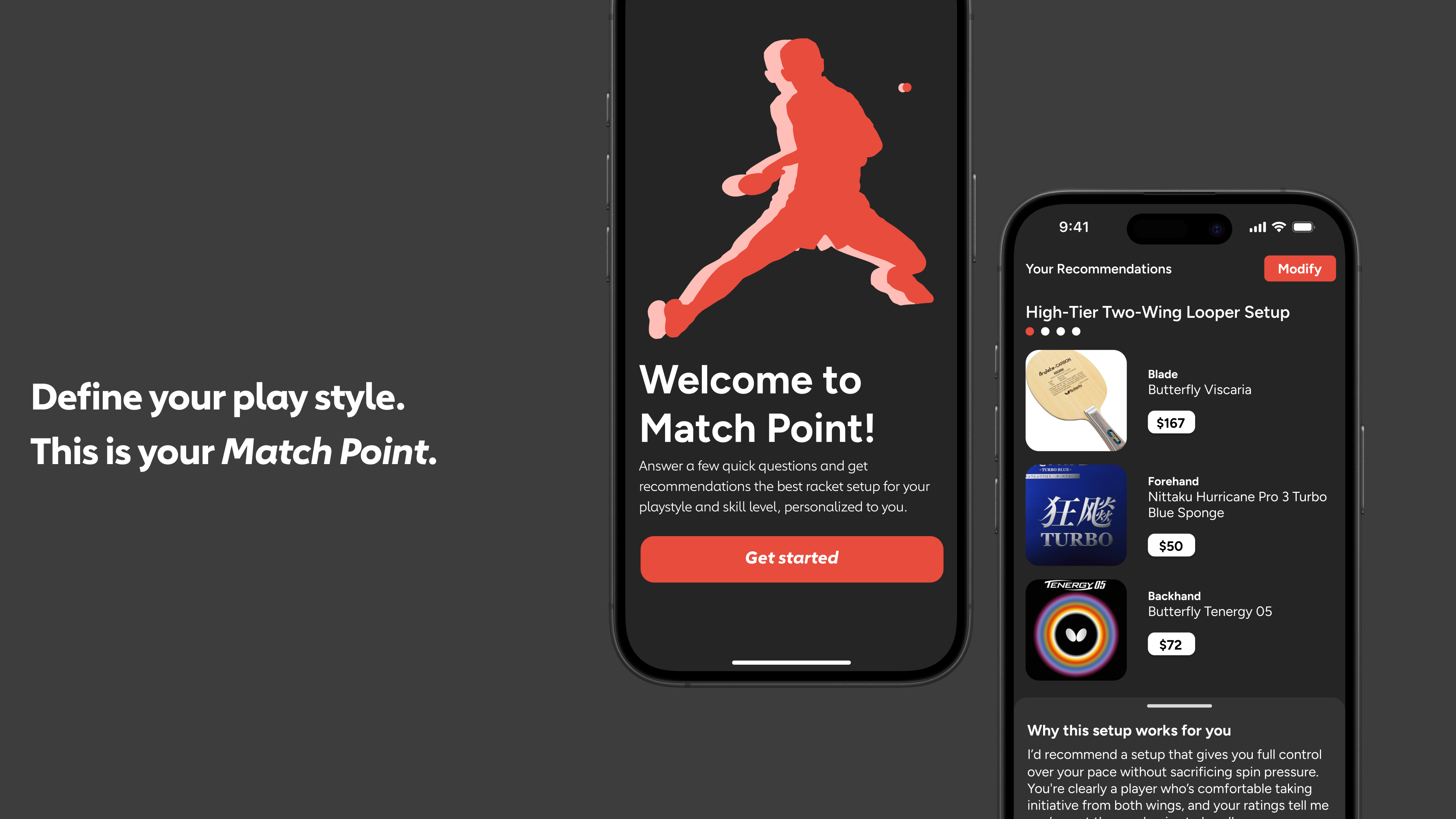
Context & Problem
Table Tennis Equipment Abstraction
Discovery & Research
Talking to Players and Organizations
To build a product that truly resonated, I talked to many players. I conducted one-on-one interviews with both intermediate and advanced table tennis players, as well as traveled to clubs across the country to observe gameplay styles, ask questions, and better understand the pain points that players experience when choosing equipment. These conversations revealed not only what players were struggling with, but why they were struggling: lack of personalized guidance, unclear gear specs, and conflicting online advice.
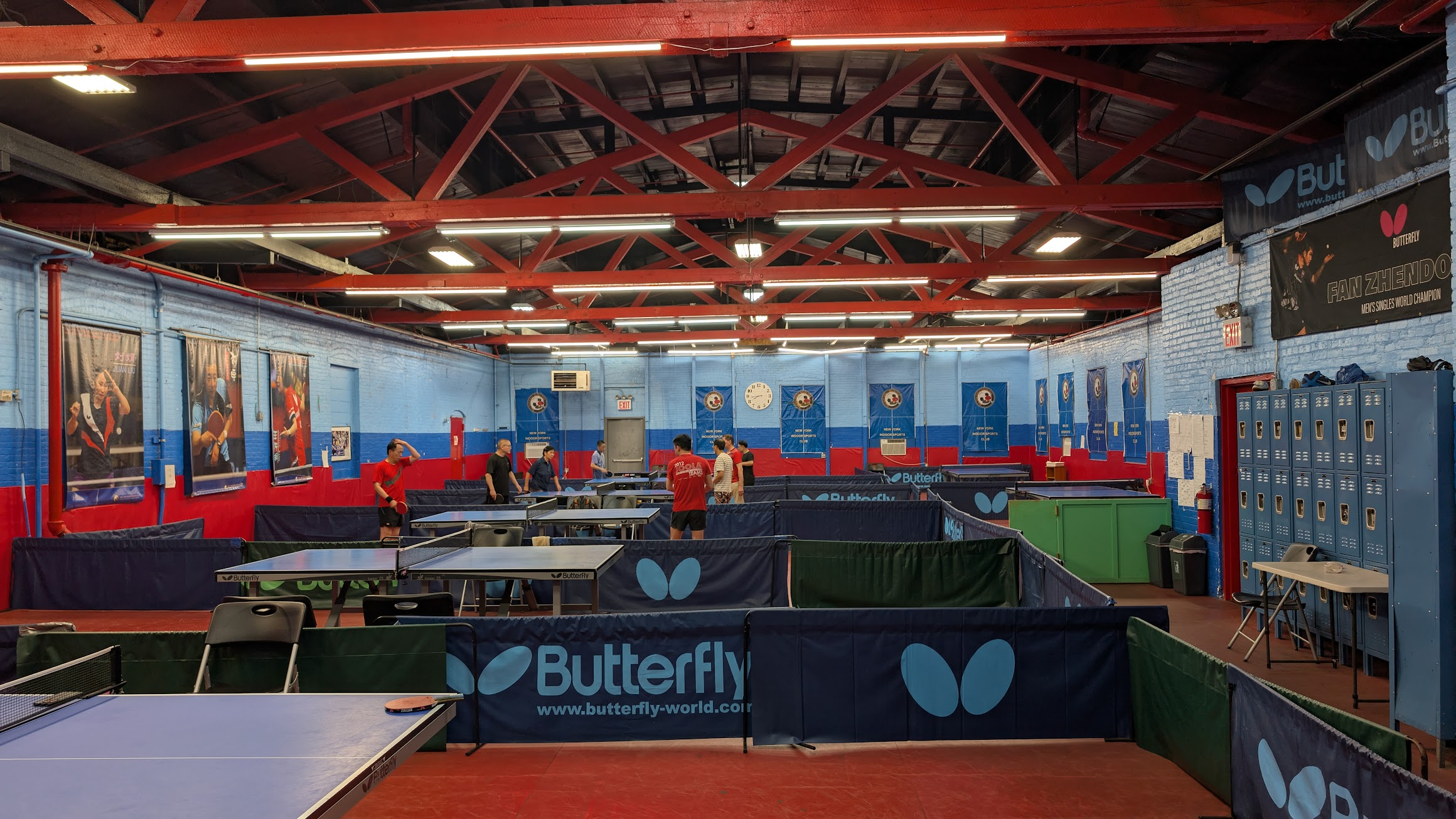
Flushing, NY
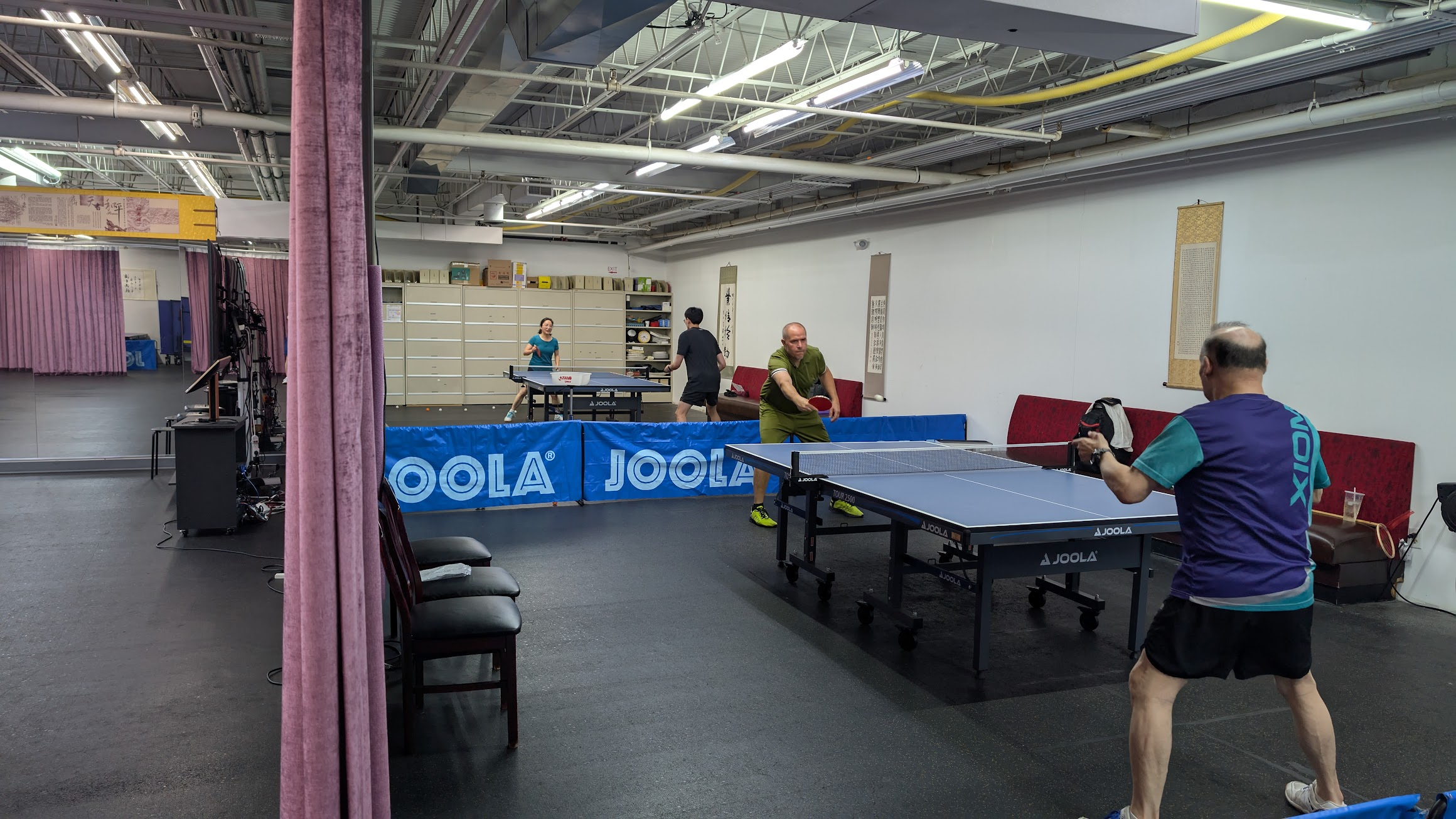
New Haven, CT
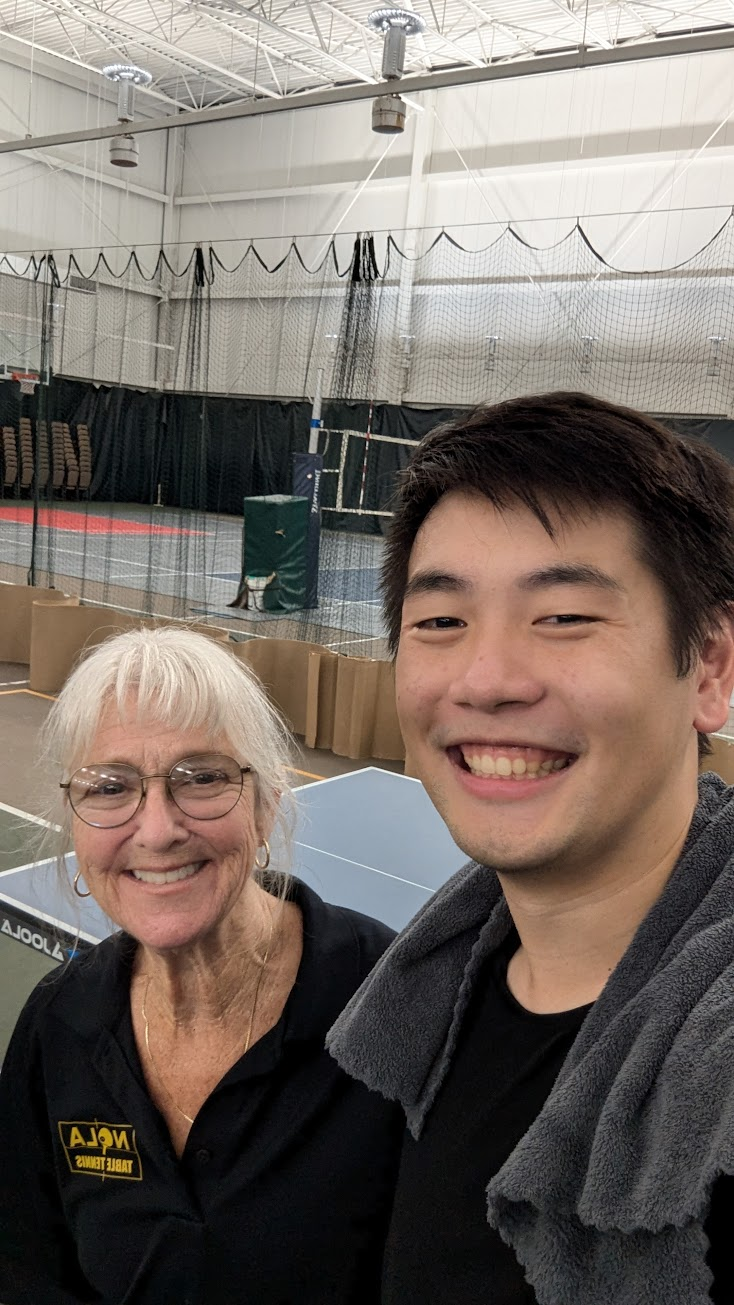
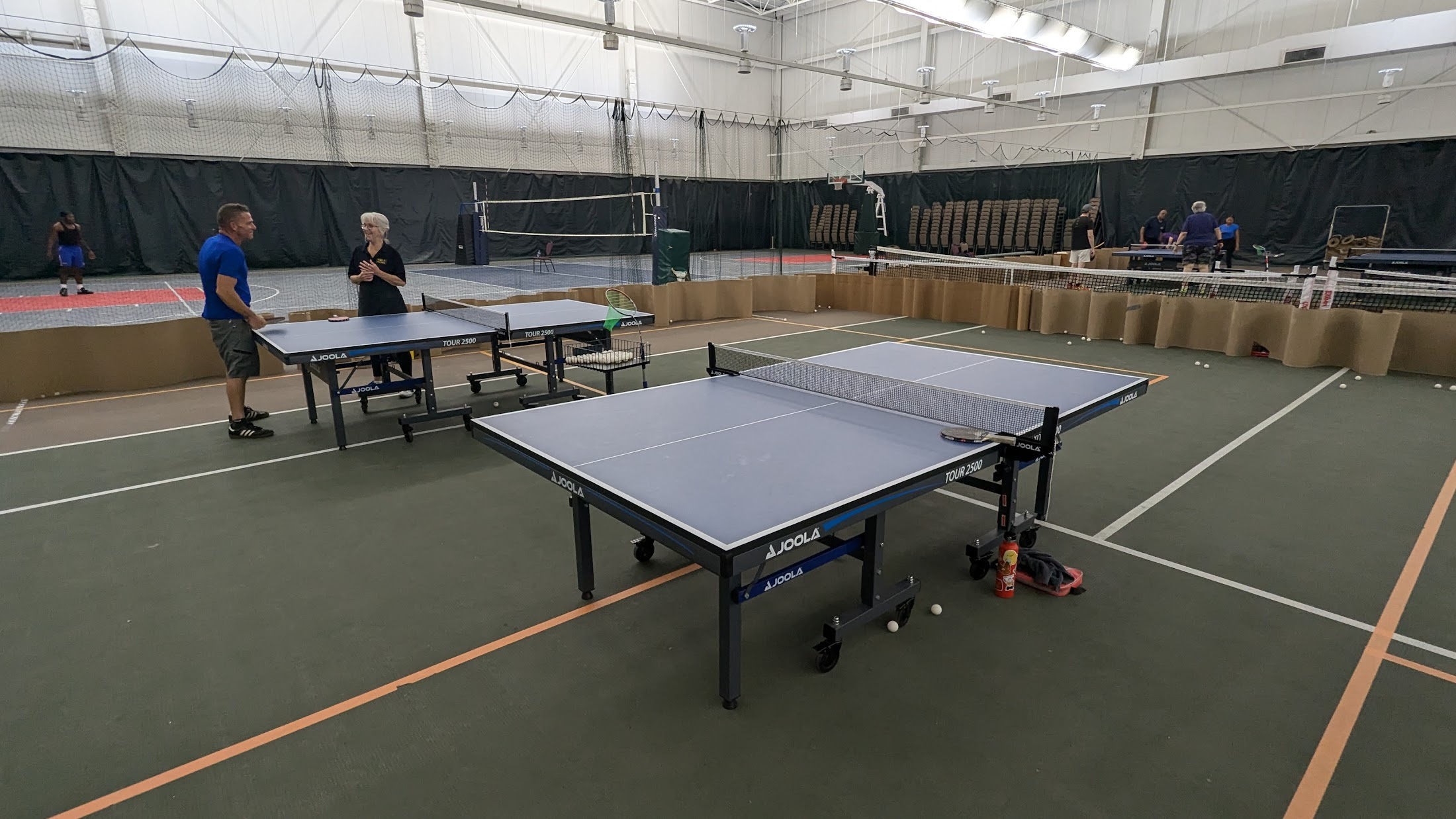
New Orleans, LA
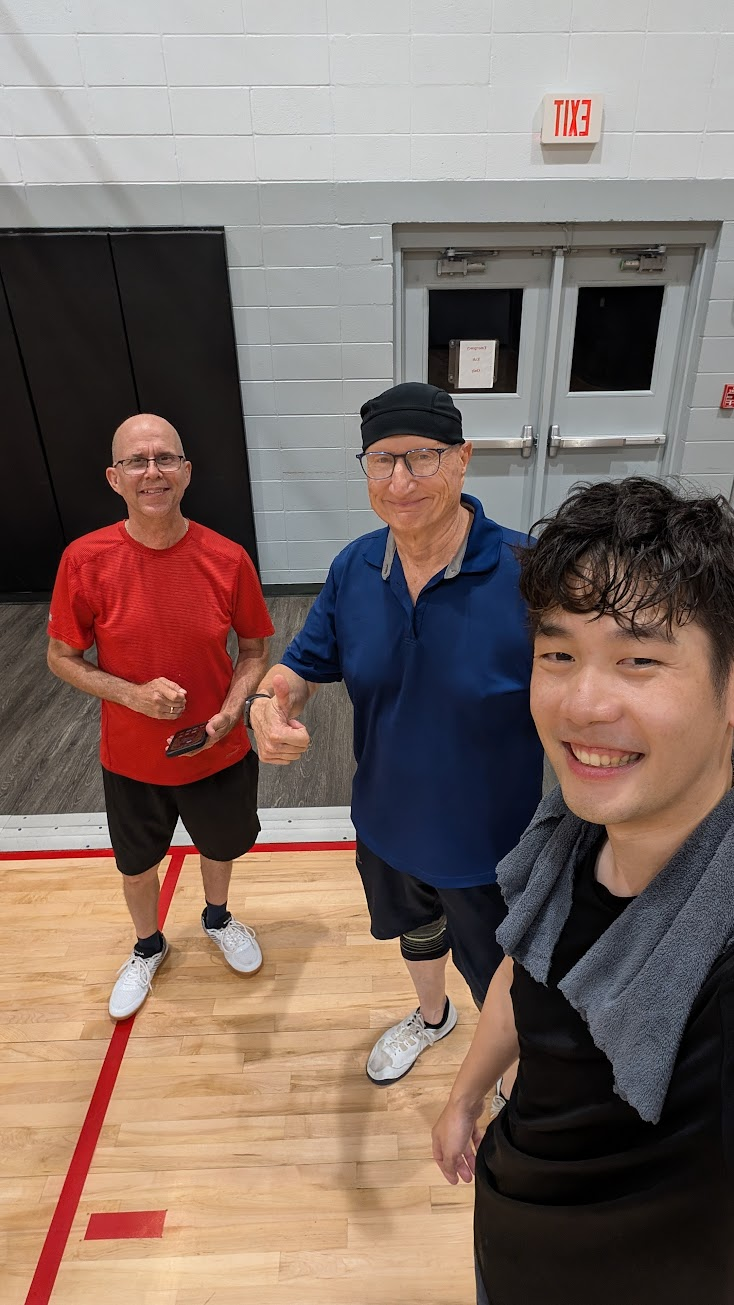
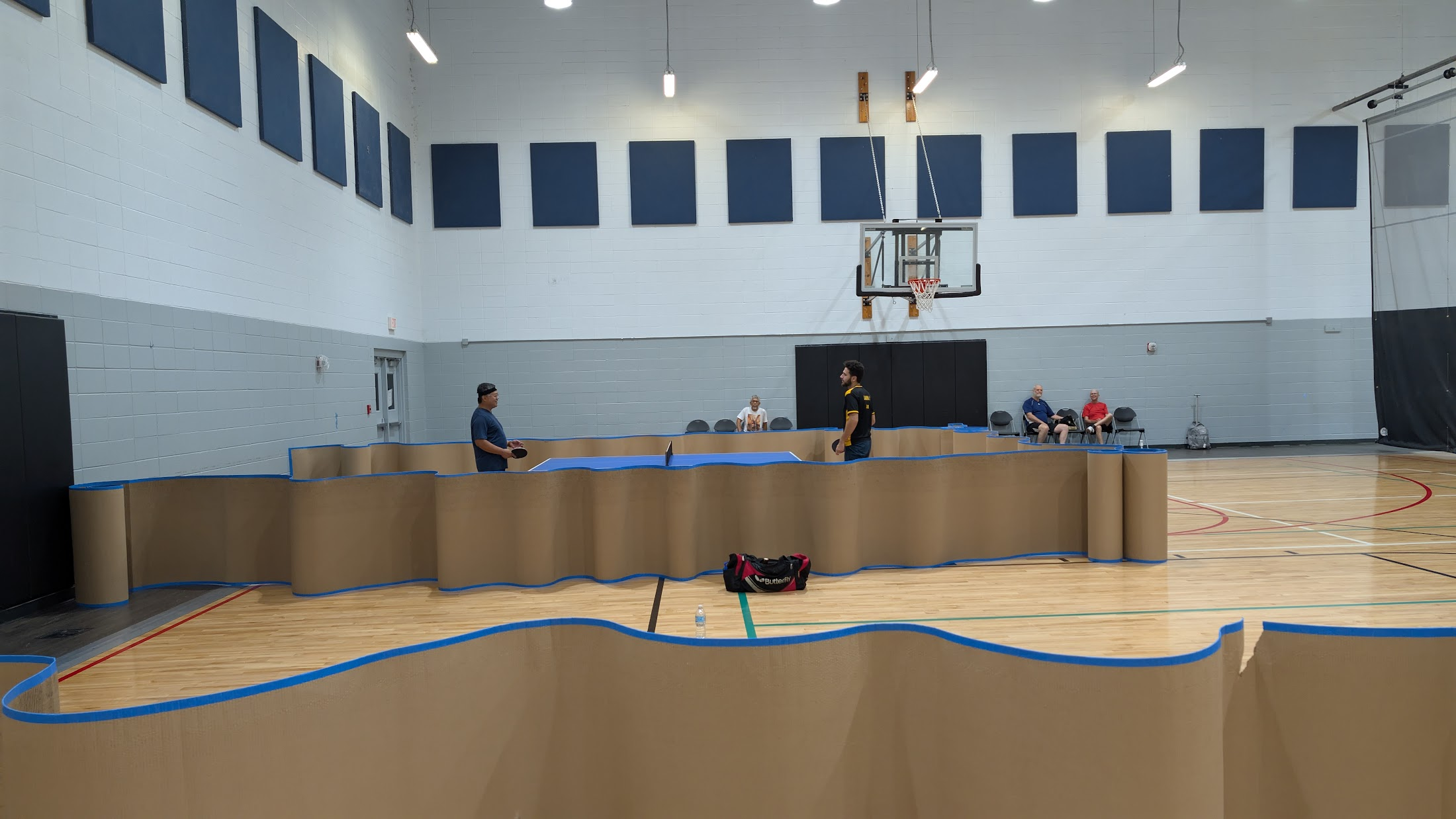
Tampa, FL
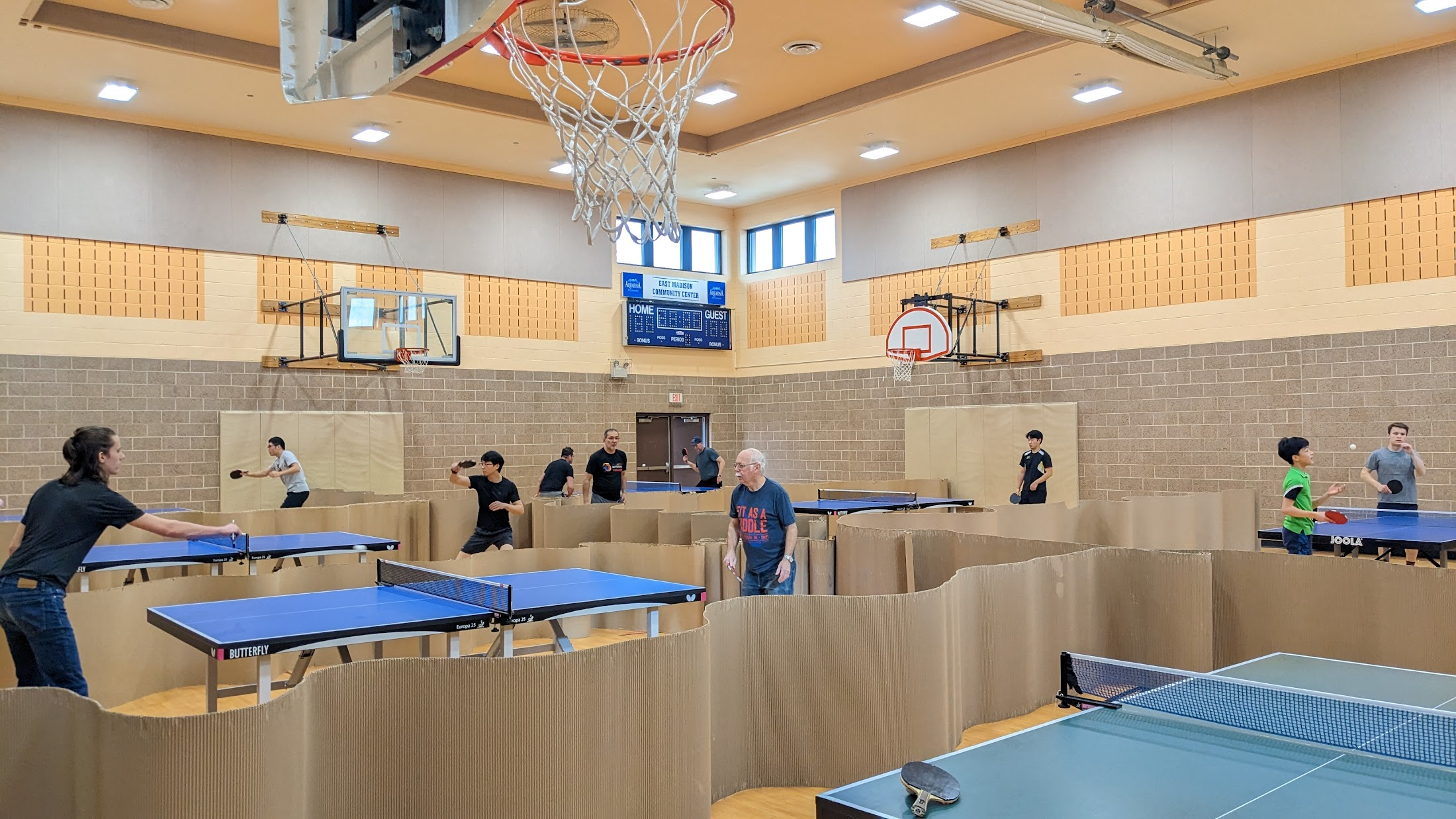
Madison, WI
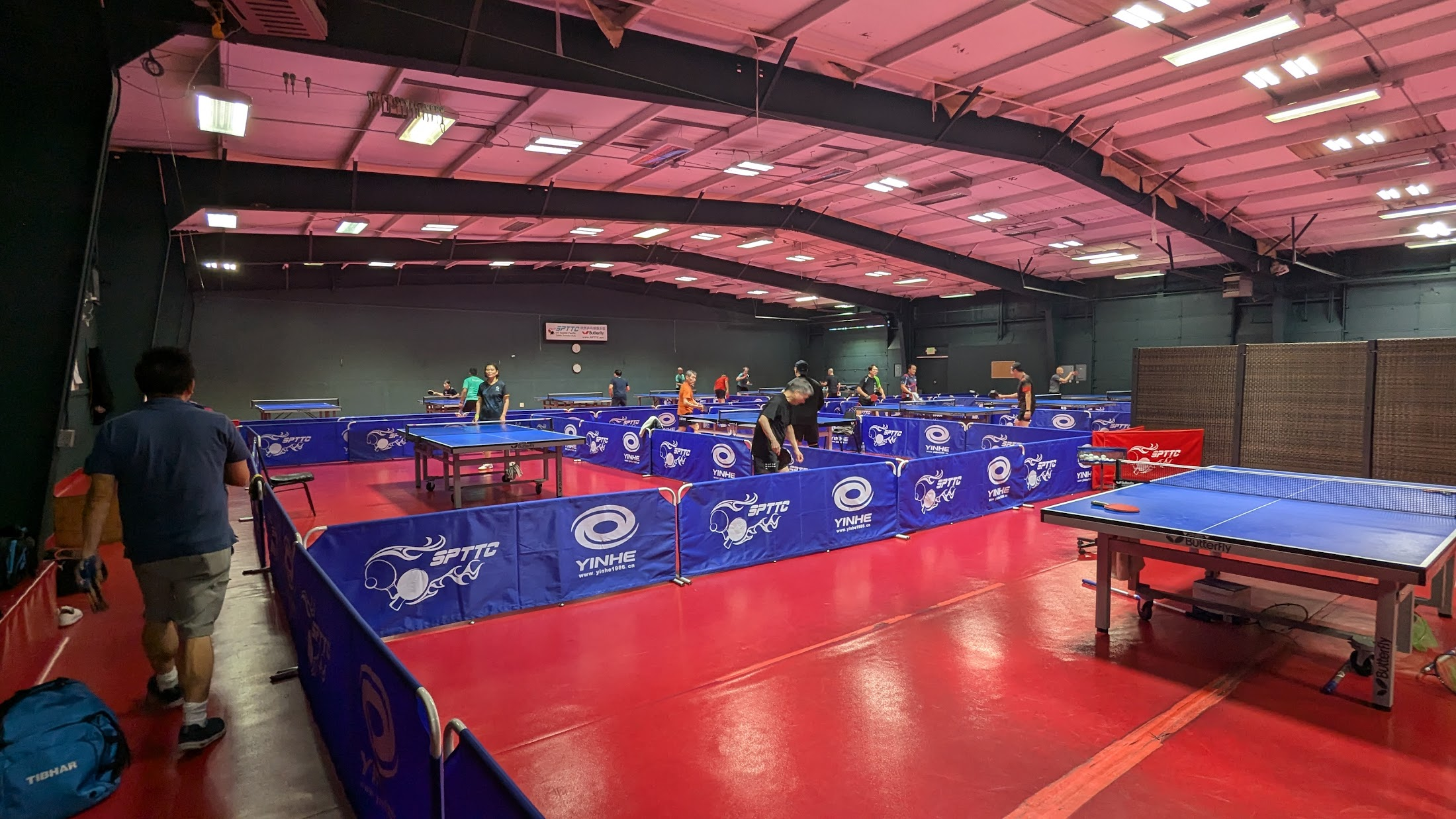
Seattle, WA
Most existing table tennis forums and e-commerce sites are not designed for beginners. Reviews are often written by advanced players, filled with jargon, and lack any personalization. On top of that, numeric ratings (like “Speed: 9.4”) feel arbitrary without meaningful context. As a result, players—especially those still developing their style—end up using gear that doesn’t match how they actually play.
Gap in the Market
There is currently no easy way for players to describe their style and get matched with gear that suits them. My challenge was to build a system that was personal, like a coach who’s seen you play, even if all you gave it was a few sentences and a self-assessment.
I also conducted a competitive analysis of existing table tennis gear recommendation experiences—primarily forums, e-commerce sites, and YouTube reviews.
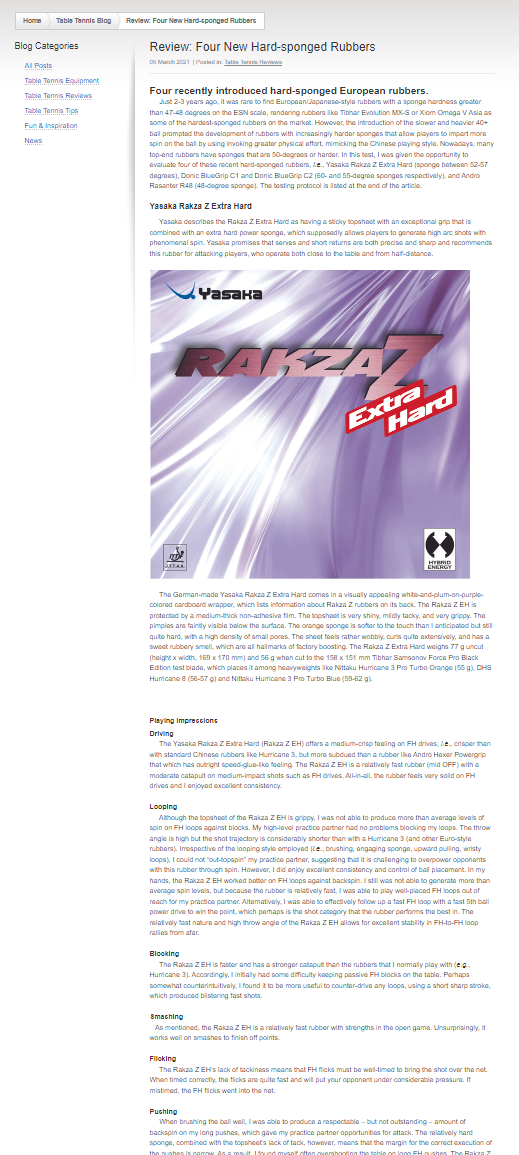
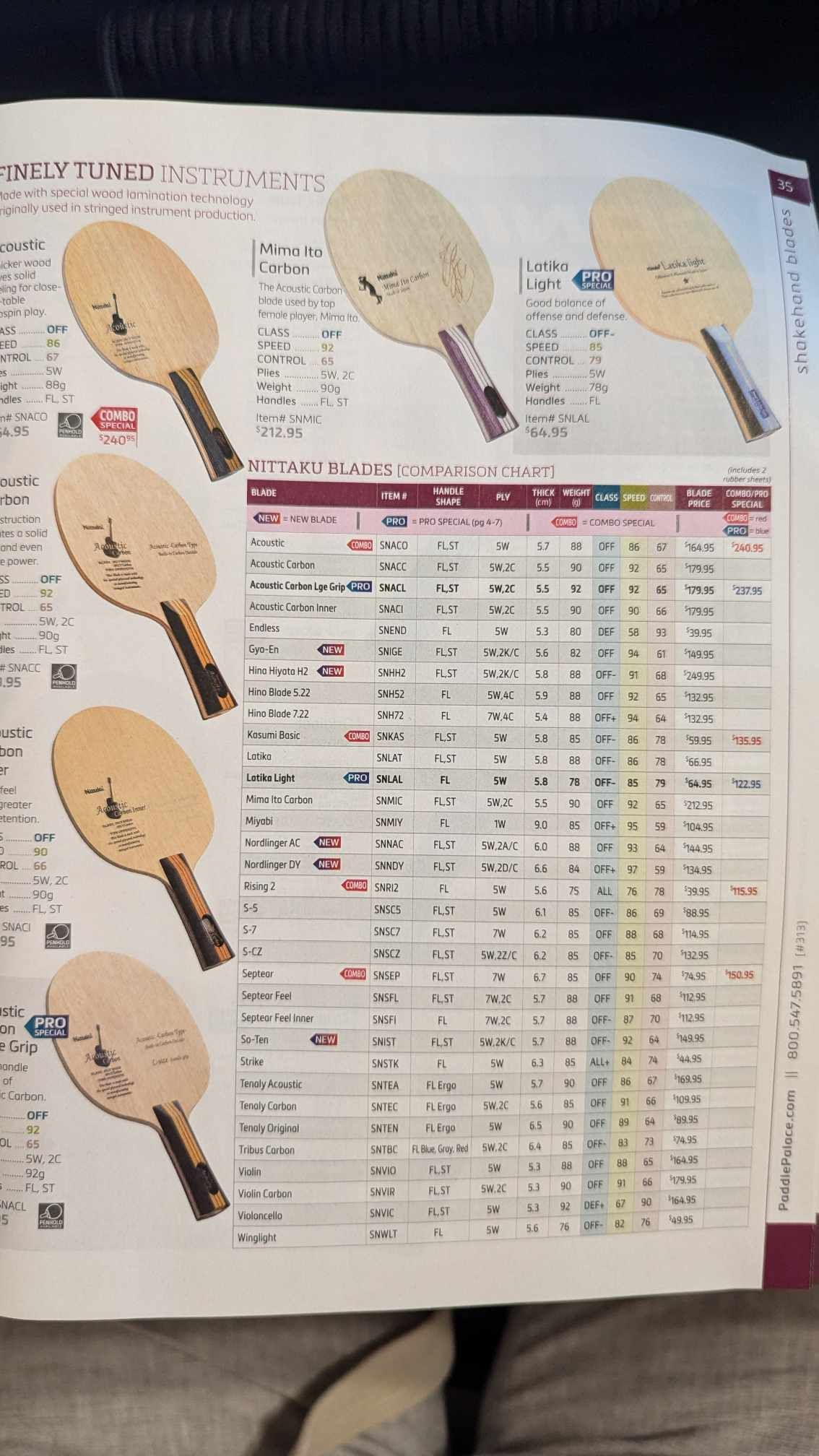
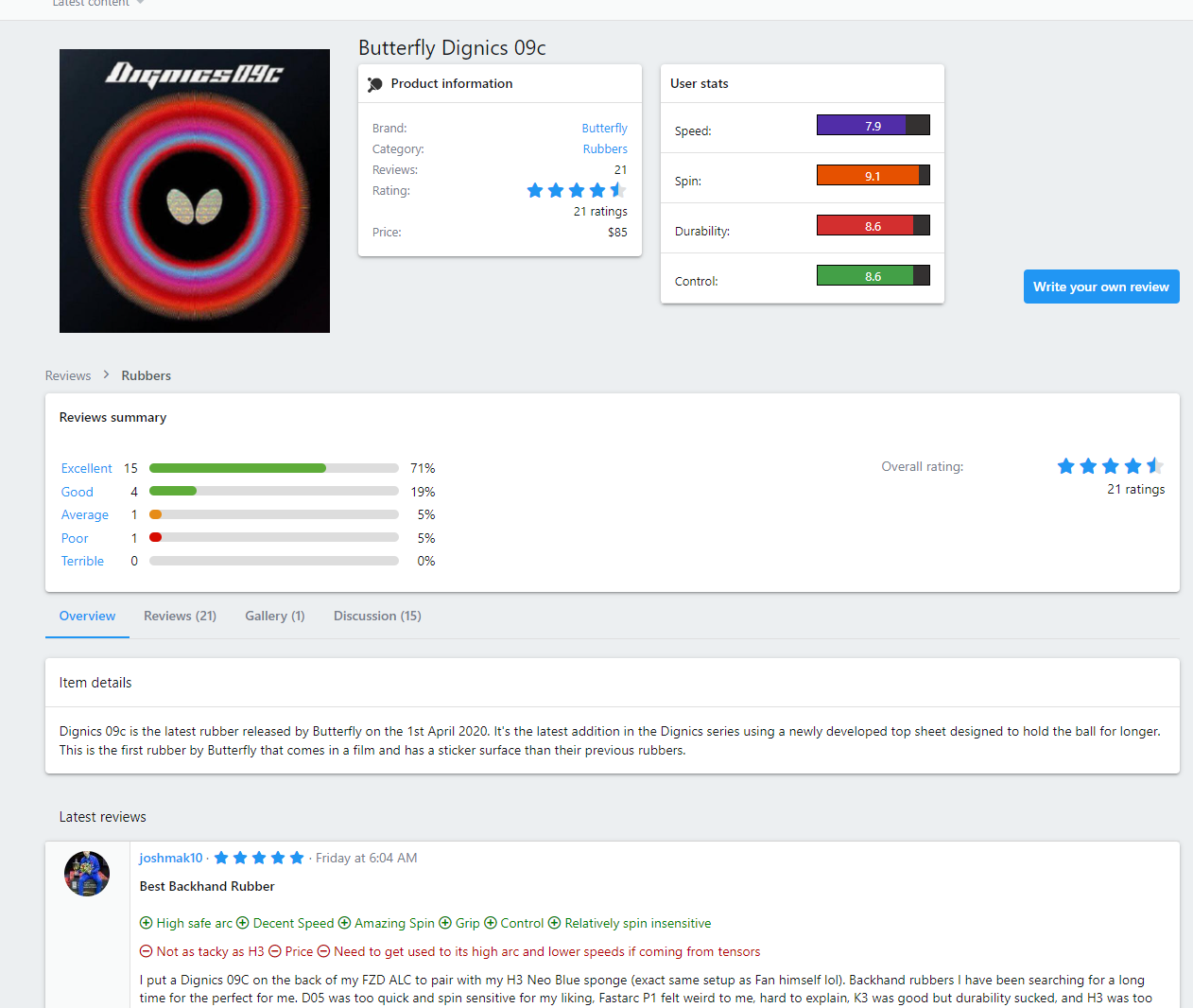
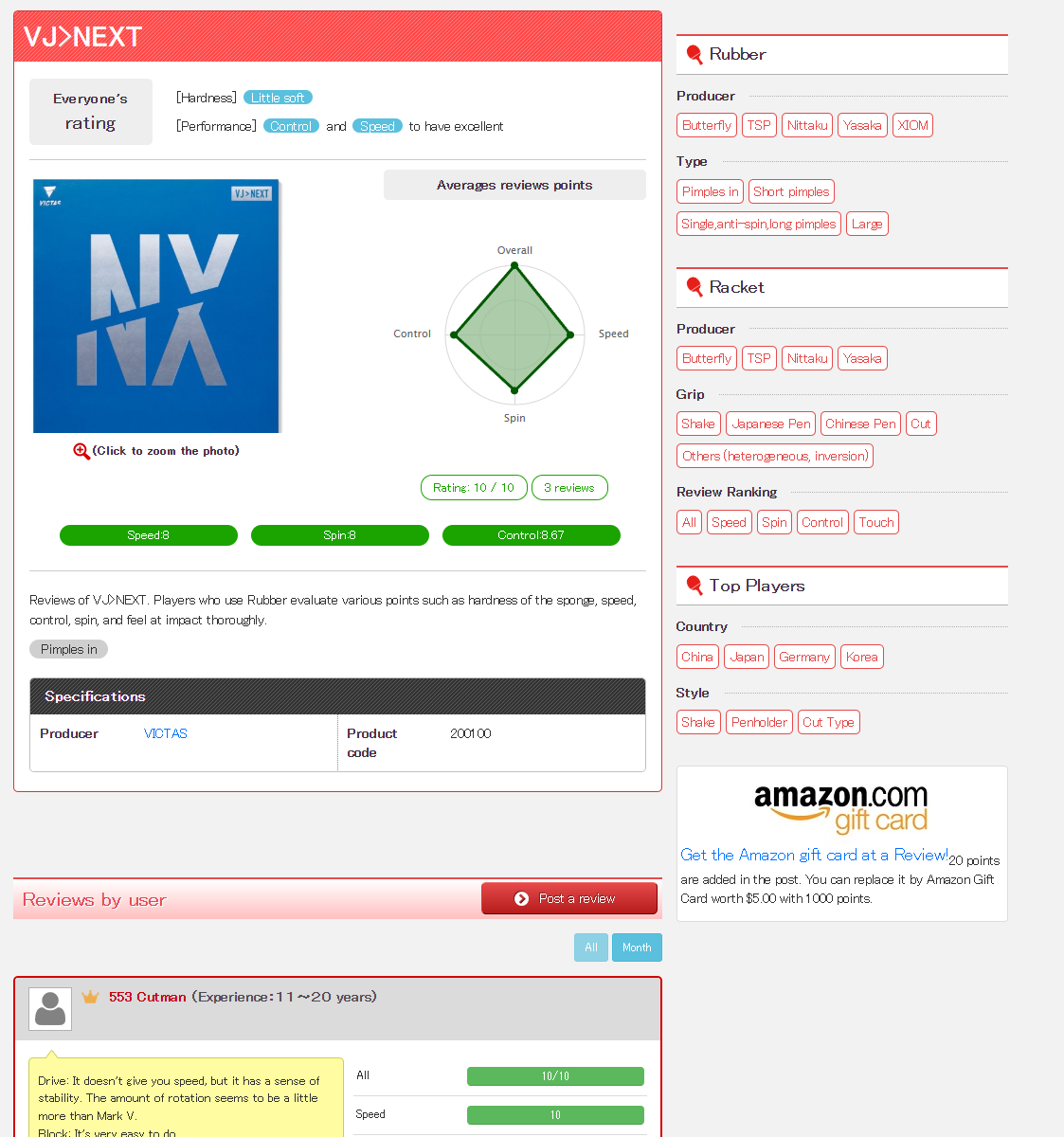
Across these sources, a few consistent pain points emerged:
Subjectivity
Reviews are highly subjective and often written by players whose needs don't align with beginners or intermediates. They don’t understand a player’s specific needs.
Numeric Ratings
Numeric ratings (e.g. “Speed: 9.4”) lack grounding, making it hard to interpret what a number actually means in practice.
Transparency
No sense of trust or transparency—players don’t understand why something is being recommended to them.
Overabundance
Overwhelming variety of options, with little guidance for someone just getting into custom setups.
What I Designed
Welcome to Match Point
Key Considerations
Specific Needs for Specific Players
Generative AI became a compelling solution from the research. If AI could understand a player’s personal play style, it would provide massive benefit to equipment recommendations.
I began with a lightweight but targeted questionnaire, intentionally short to reduce friction. The goal was to ask questions that had the highest impact in equipment decisions. These were determined based on numerous interviews and strategies already used to determine equipment fit.
Skill Level
This helps to understand the level of the player taking the questionnaire. If the player doesn’t have a rating, the tool would ask for their level instead.
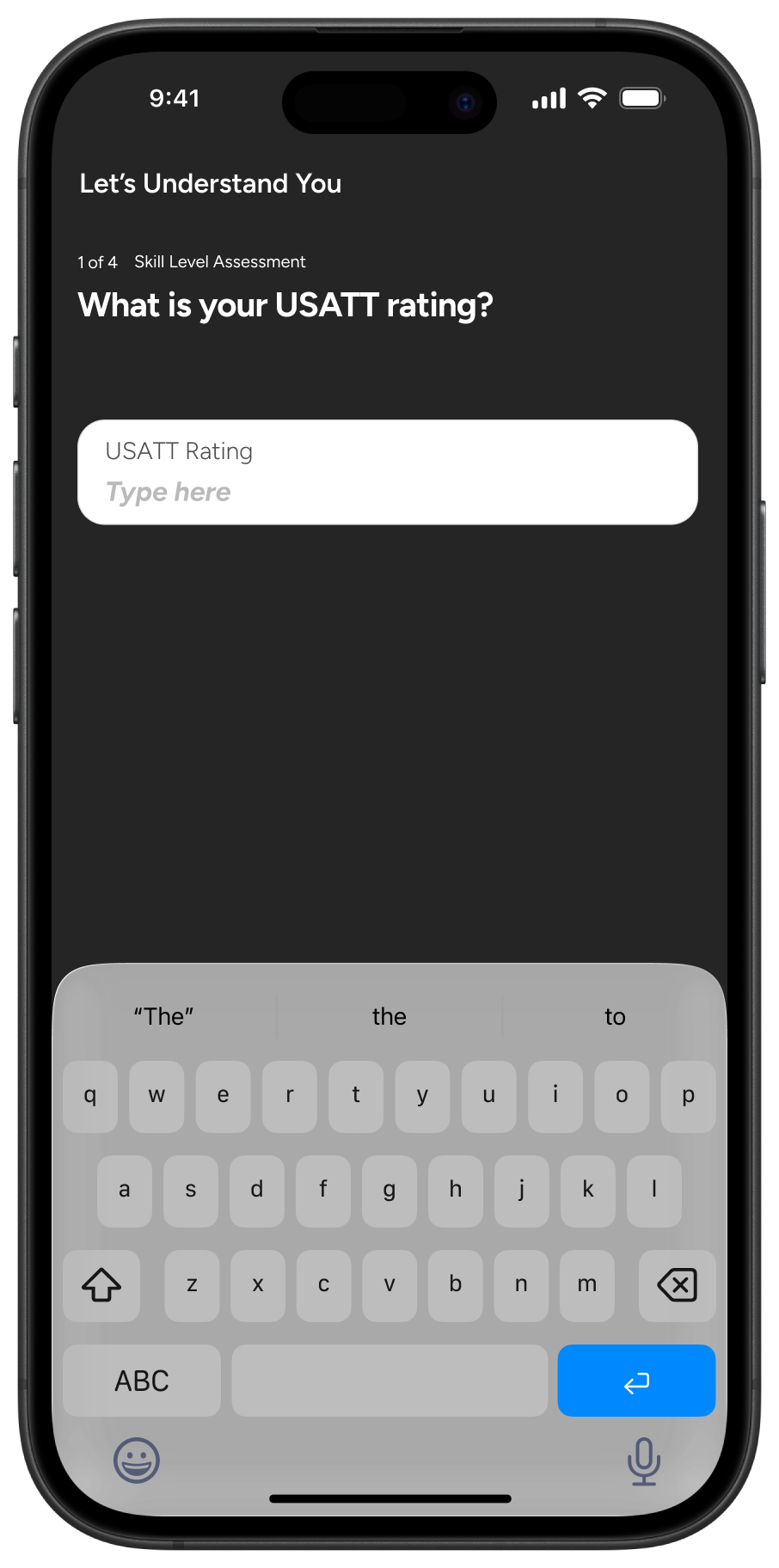
Playstyle Description
This one is the most important and impactful through AI. If a player could accurately describe how they play, we could match keywords to specific pieces of equipment that could tailor their playstyle.

Core Shot Ratings
Player confidence in shots also helps to recommend easier or more difficult rubbers and paddles.
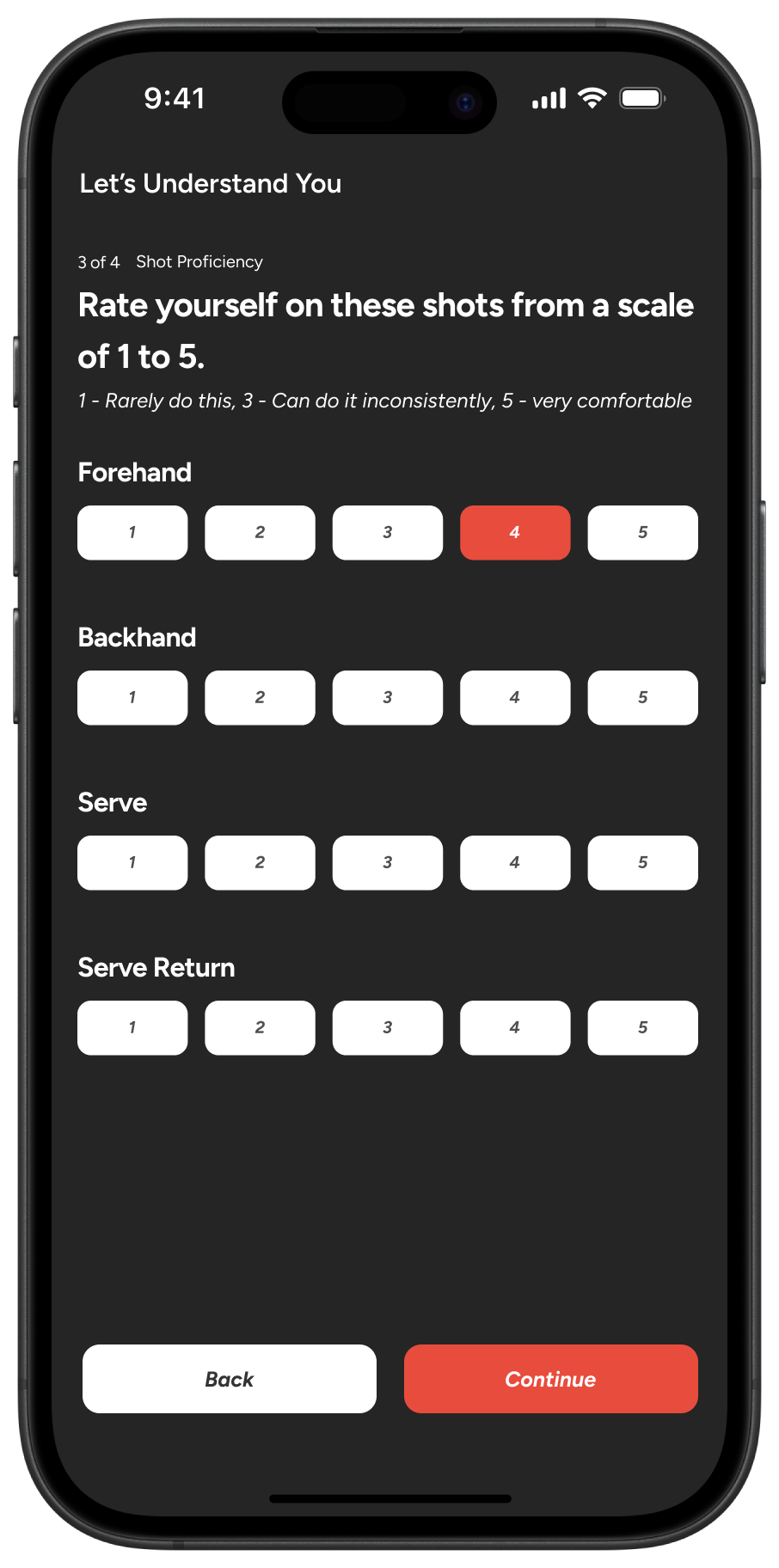
Player Intent
This helps to tailor variety and give intentional recommendations.
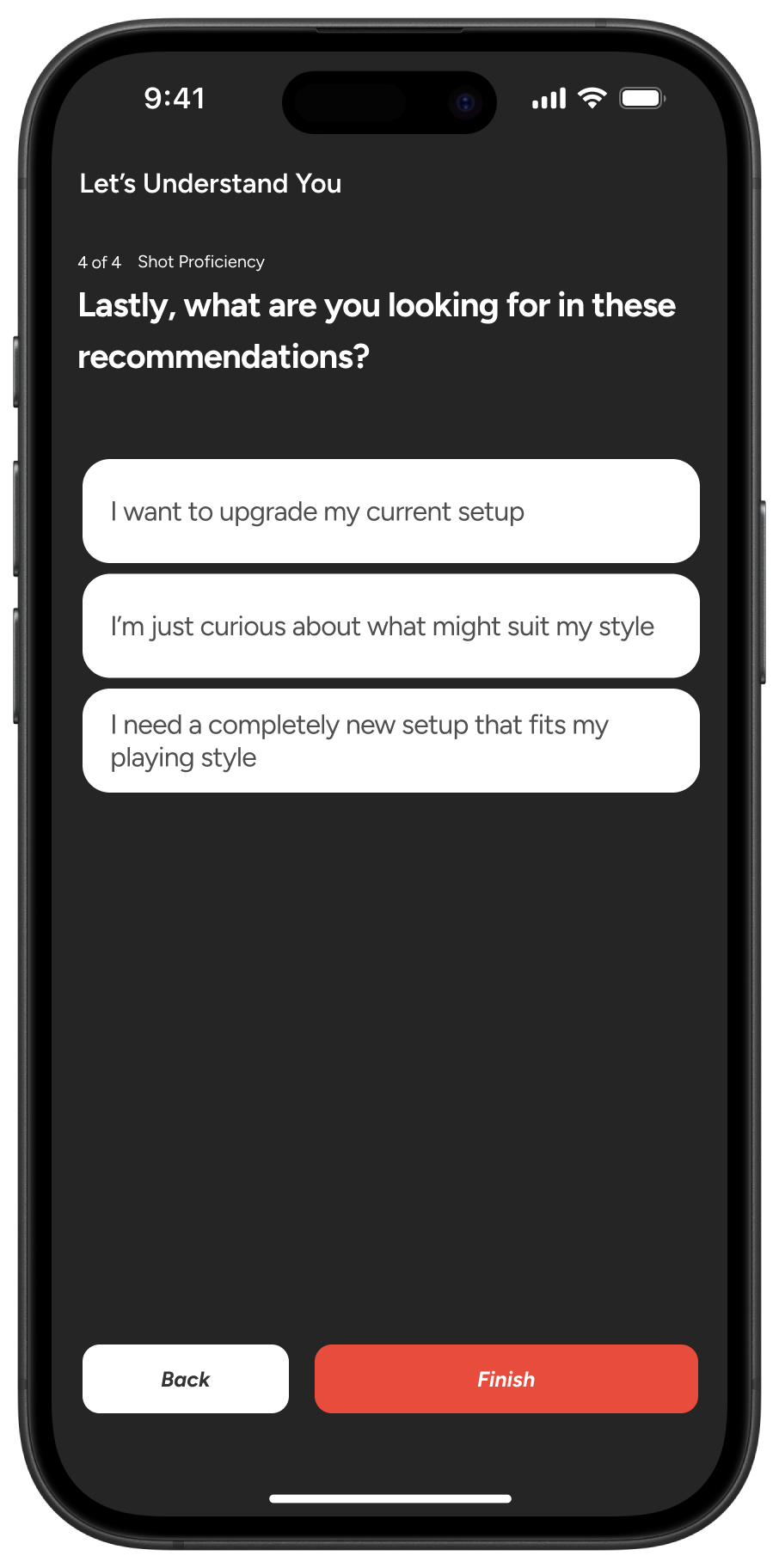
Match point is a two-part experience:
1 - Short Questionnaire
Players answer 3–4 high-impact questions that determine play style
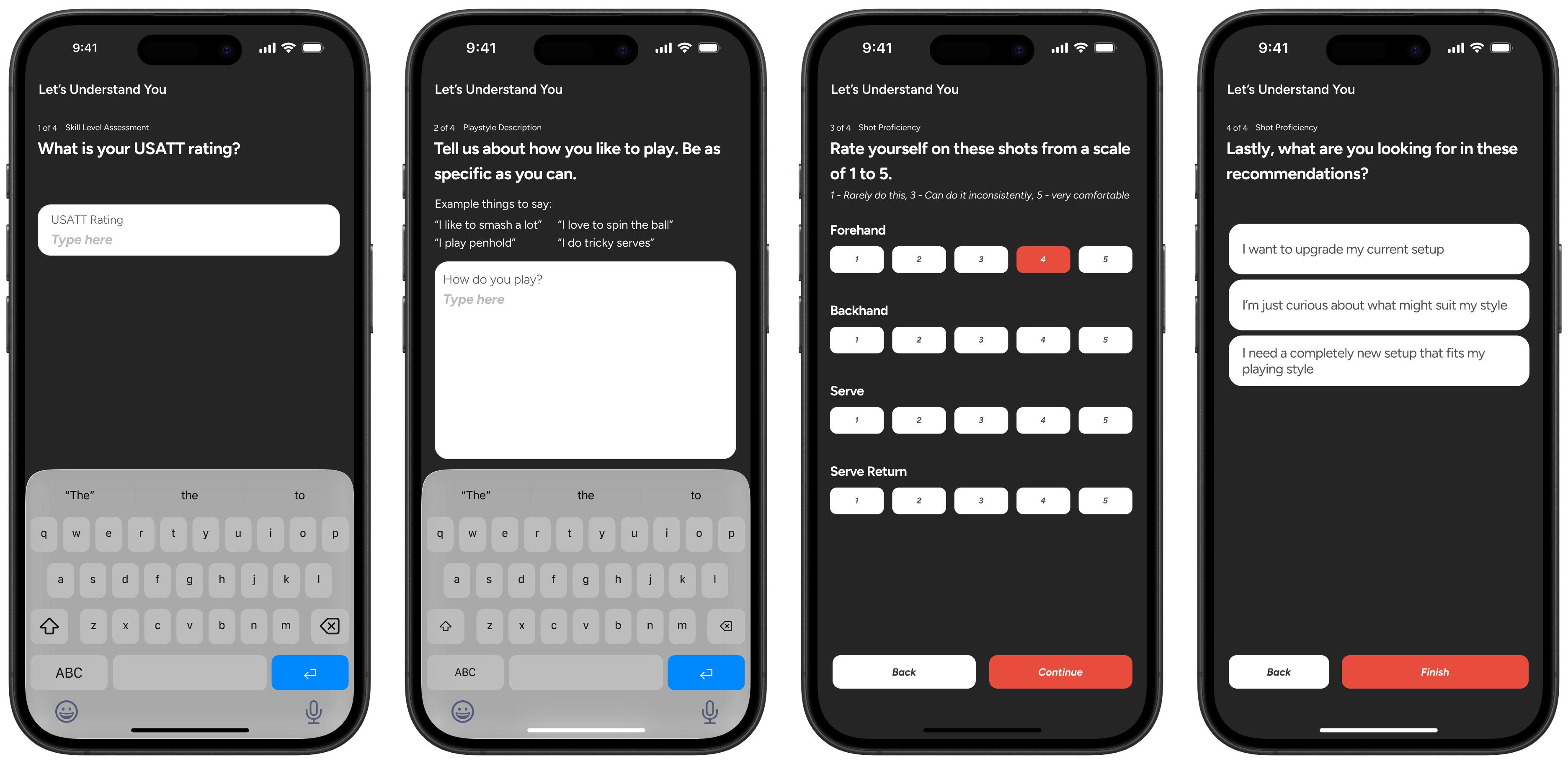
2 - Recommended Equipment
Includes a blade + rubbers combo, a personalized explanation of the setup and each equipment piece, 2–5 tags for transparency, and multiple variants for different budgets or playstyle learnings.
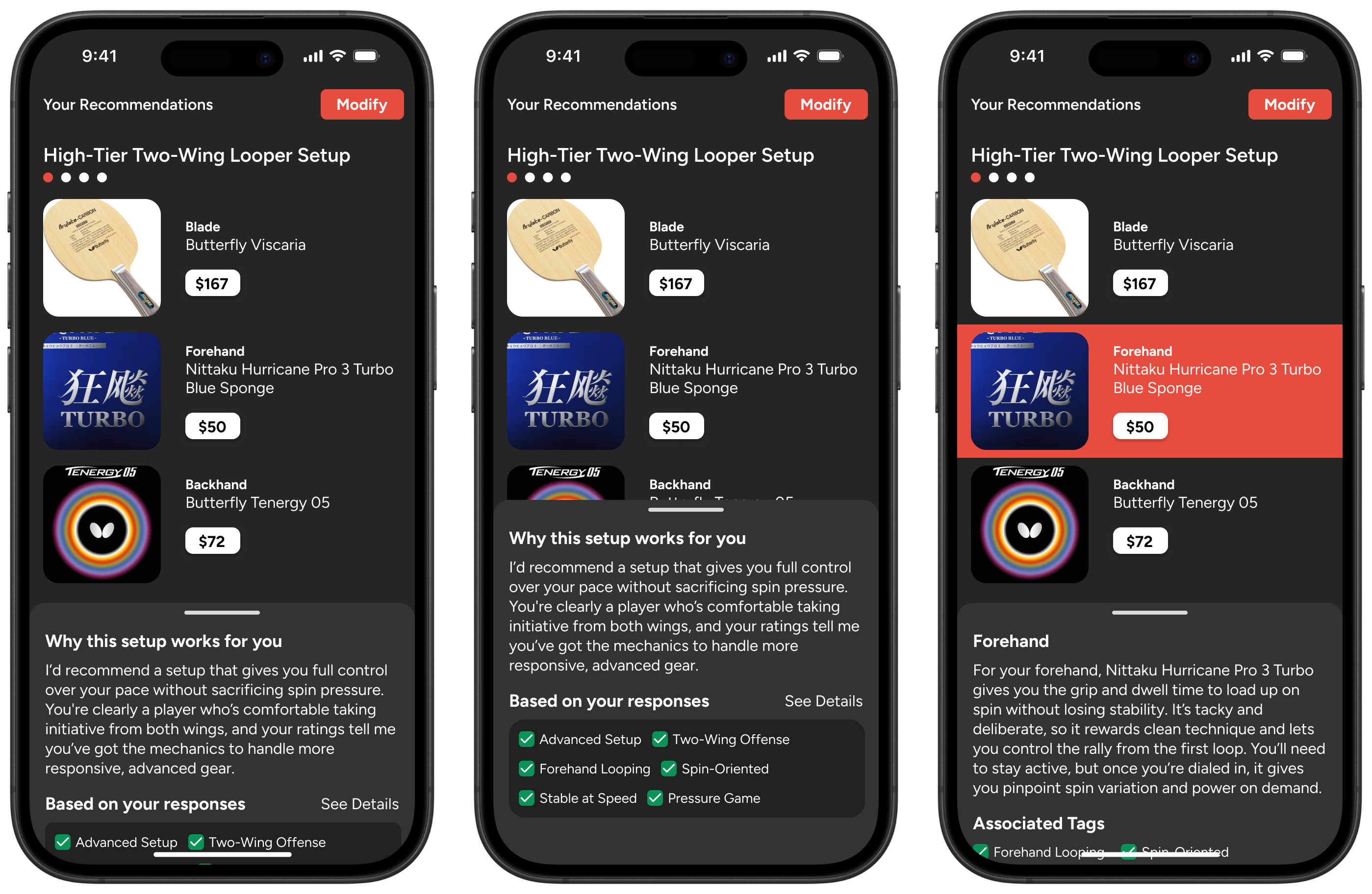
Tags
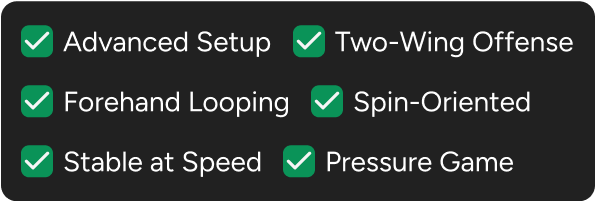
Equipment Recommendation
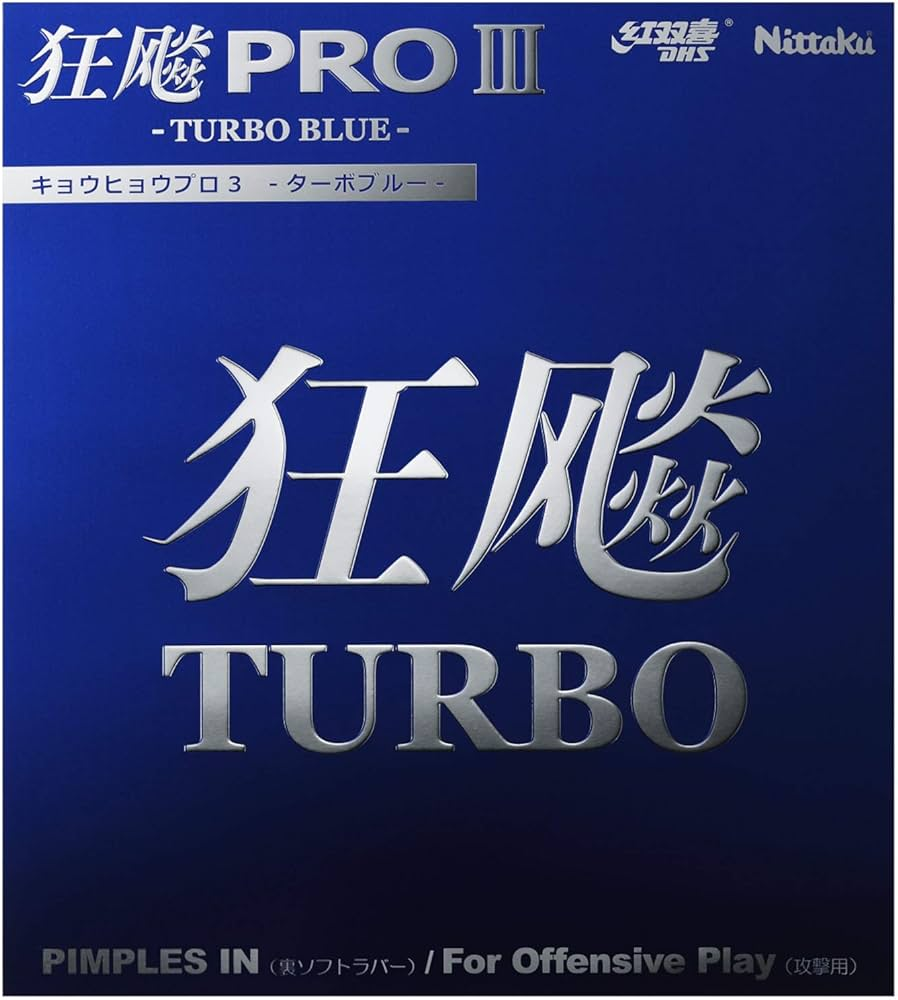
Forehand
Nittaku Hurricane Pro 3 Turbo Blue Sponge
$50
Personalized Explanation
The tone is clear and encouraging, with explanations that feel like advice from a seasoned player or coach.
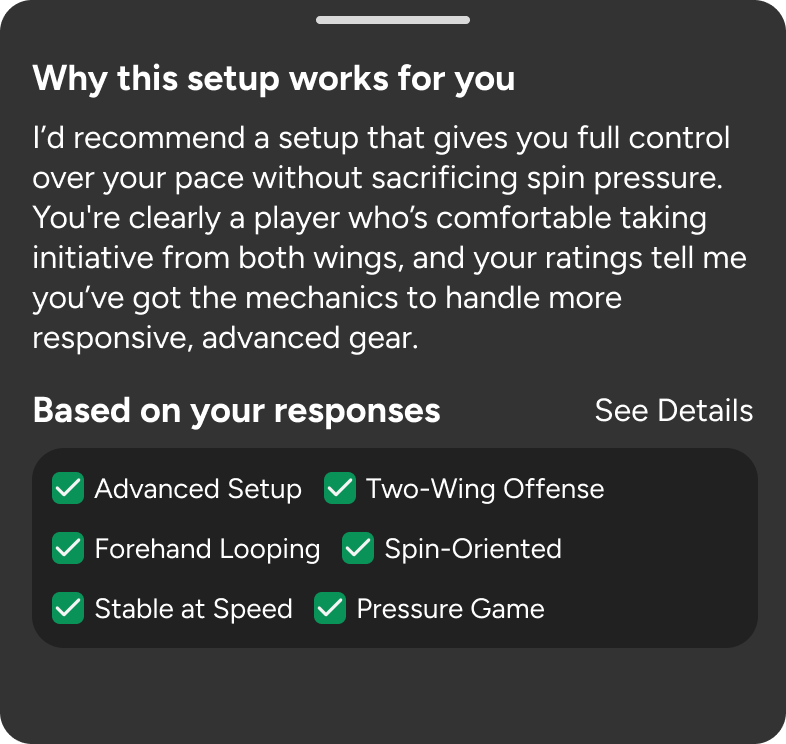
Impact & Future
Meaningful Features
This project showed me how deeply personal even niche tools can be. For many players, gear is an extension of identity: how they play, how they think, what they aspire to. The key wasn’t giving the most advanced gear, it was giving the gear that made people feel seen.
From a product standpoint, I learned:
- Start simple: earn trust, and invite depth
- Transparency builds confidence: Explaining why matters more than what
- AI can humanize, not just automate: LLMs were crucial in interpreting freeform input and returning smart, scalable matches
From a product standpoint, I learned:
- Start simple: earn trust, and invite depth
- Transparency builds confidence: Explaining why matters more than what
- AI can humanize, not just automate: LLMs were crucial in interpreting freeform input and returning smart, scalable matches
Future Plans
In the future, I’d love to expand the product to include three things: conversational follow ups to equipment recommendations, saving equipment recommendations, and a comparison tool for more granularity.
With the help of AI and table tennis becoming more popular, resources and information will become more accessible and can help better inform the system on best recommdnations.
Back to Home

Match Point
Helping Local Table Tennis Players
Access and understanding of table tennis equipment is extremely difficult for up and coming players who don’t have the resources, knowledge, or coaches to help them.
Match Point is a tool that helps newer table tennis players discover equipment tailored to their individual play style, skill level, and goals. Using AI and natural language, players take a short quiz and optional refinement questions and receive gear recommendations that reflect how they actually play, not just how others review equipment online.
By giving players clear, transparent reasons behind each recommendation, Match Point turns a traditionally confusing, subjective process into one that’s simple, personal, and actionable.
See Final Designs
Use the Equipment Recommender GPT
Community Outcomes
High Accuracy
most test cases used in the questionnaire accurately recommended equipment to player archetypes, validated by seasoned professionals and players.
Usage of Recommendations
5 out of 6 players at the local club who used the tool continue to use setups recommended to them.
My Role
Designer & Creator, 2025
Collaboration
Partnered with players and table tennis clubs across the country to validate these recommendations.
Scope
UI Design, Custom ChatGPT Questionnaire

Context & Problem
Table Tennis Equipment Abstraction
Discovery & Research
Talking to Players and Organizations
To build a product that truly resonated, I talked to many players. I conducted one-on-one interviews with both intermediate and advanced table tennis players, as well as traveled to clubs across the country to observe gameplay styles, ask questions, and better understand the pain points that players experience when choosing equipment. These conversations revealed not only what players were struggling with, but why they were struggling: lack of personalized guidance, unclear gear specs, and conflicting online advice.

Flushing, NY

New Haven, CT


New Orleans, LA


Tampa, FL

Madison, WI

Seattle, WA
Most existing table tennis forums and e-commerce sites are not designed for beginners. Reviews are often written by advanced players, filled with jargon, and lack any personalization. On top of that, numeric ratings (like “Speed: 9.4”) feel arbitrary without meaningful context. As a result, players—especially those still developing their style—end up using gear that doesn’t match how they actually play.
Gap in the Market
There is currently no easy way for players to describe their style and get matched with gear that suits them. My challenge was to build a system that was personal, like a coach who’s seen you play, even if all you gave it was a few sentences and a self-assessment.
I also conducted a competitive analysis of existing table tennis gear recommendation experiences—primarily forums, e-commerce sites, and YouTube reviews.



Across these sources, a few consistent pain points emerged:
Subjectivity
Reviews are highly subjective and often written by players whose needs don't align with beginners or intermediates. They don’t understand a player’s specific needs.
Numeric Ratings
Numeric ratings (e.g. “Speed: 9.4”) lack grounding, making it hard to interpret what a number actually means in practice.
Transparency
No sense of trust or transparency—players don’t understand why something is being recommended to them.
Overabundance
Overwhelming variety of options, with little guidance for someone just getting into custom setups.
What I Designed
Welcome to Match Point
Key Considerations
Specific Needs for Specific Players
Generative AI became a compelling solution from the research. If AI could understand a player’s personal play style, it would provide massive benefit to equipment recommendations.
I began with a lightweight but targeted questionnaire, intentionally short to reduce friction. The goal was to ask questions that had the highest impact in equipment decisions. These were determined based on numerous interviews and strategies already used to determine equipment fit.
Skill Level
This helps to understand the level of the player taking the questionnaire. If the player doesn’t have a rating, the tool would ask for their level instead.


Playstyle Description
This one is the most important and impactful through AI. If a player could accurately describe how they play, we could match keywords to specific pieces of equipment that could tailor their playstyle.

Core Shot Ratings
Player confidence in shots also helps to recommend easier or more difficult rubbers and paddles.

Player Intent
This helps to tailor variety and give intentional recommendations.

Match point is a two-part experience:
1 - Short Questionnaire
Players answer 3–4 high-impact questions that determine play style

2 - Recommended Equipment
Includes a blade + rubbers combo, a personalized explanation of the setup and each equipment piece, 2–5 tags for transparency, and multiple variants for different budgets or playstyle learnings.

Tags
Advanced Setup
Forehand Looping
Stable at Speed
Two-Wing Offense
Spin-Oriented
Pressure Game
Equipment Recommendation

Forehand
Nittaku Hurricane Pro 3 Turbo Blue Sponge
$50
Personalized Explanation
The tone is clear and encouraging, with explanations that feel like advice from a seasoned player or coach.

Impact & Future
Meaningful Features
This project showed me how deeply personal even niche tools can be. For many players, gear is an extension of identity: how they play, how they think, what they aspire to. The key wasn’t giving the most advanced gear, it was giving the gear that made people feel seen.
From a product standpoint, I learned:
- Start simple: earn trust, and invite depth
- Transparency builds confidence: Explaining why matters more than what
- AI can humanize, not just automate: LLMs were crucial in interpreting freeform input and returning smart, scalable matches
From a product standpoint, I learned:
- Start simple: earn trust, and invite depth
- Transparency builds confidence: Explaining why matters more than what
- AI can humanize, not just automate: LLMs were crucial in interpreting freeform input and returning smart, scalable matches
Future Plans
In the future, I’d love to expand the product to include three things: conversational follow ups to equipment recommendations, saving equipment recommendations, and a comparison tool for more granularity.
With the help of AI and table tennis becoming more popular, resources and information will become more accessible and can help better inform the system on best recommdnations.
Back to Home

Match Point
Helping Local Table Tennis Players
Access and understanding of table tennis equipment is extremely difficult for up and coming players who don’t have the resources, knowledge, or coaches to help them.
Match Point is a tool that helps newer table tennis players discover equipment tailored to their individual play style, skill level, and goals. Using AI and natural language, players take a short quiz and optional refinement questions and receive gear recommendations that reflect how they actually play, not just how others review equipment online.
By giving players clear, transparent reasons behind each recommendation, Match Point turns a traditionally confusing, subjective process into one that’s simple, personal, and actionable.
See Final Designs
Use the Equipment Recommender GPT
Community Outcomes
High Accuracy
most test cases used in the questionnaire accurately recommended equipment to player archetypes, validated by seasoned professionals and players.
Usage of Recommendations
5 out of 6 players at the local club who used the tool continue to use setups recommended to them.
My Role
Designer & Creator
2025
Collaboration
Partnered with players and table tennis clubs across the country to validate these recommendations.
Scope
UI Design, Custom ChatGPT Questionnaire

Context & Problem
Table Tennis Equipment Abstraction
Discovery & Research
Talking to Players and Organizations
To build a product that truly resonated, I talked to many players. I conducted one-on-one interviews with both intermediate and advanced table tennis players, as well as traveled to clubs across the country to observe gameplay styles, ask questions, and better understand the pain points that players experience when choosing equipment. These conversations revealed not only what players were struggling with, but why they were struggling: lack of personalized guidance, unclear gear specs, and conflicting online advice.

Flushing, NY

New Haven, CT


New Orleans, LA


Tampa, FL

Madison, WI

Seattle, WA
Most existing table tennis forums and e-commerce sites are not designed for beginners. Reviews are often written by advanced players, filled with jargon, and lack any personalization. On top of that, numeric ratings (like “Speed: 9.4”) feel arbitrary without meaningful context. As a result, players—especially those still developing their style—end up using gear that doesn’t match how they actually play.
Gap in the Market
There is currently no easy way for players to describe their style and get matched with gear that suits them. My challenge was to build a system that was personal, like a coach who’s seen you play, even if all you gave it was a few sentences and a self-assessment.
I also conducted a competitive analysis of existing table tennis gear recommendation experiences—primarily forums, e-commerce sites, and YouTube reviews.




Across these sources, a few consistent pain points emerged:
Subjectivity
Reviews are highly subjective and often written by players whose needs don't align with beginners or intermediates. They don’t understand a player’s specific needs.
Numeric Ratings
Numeric ratings (e.g. “Speed: 9.4”) lack grounding, making it hard to interpret what a number actually means in practice.
Transparency
No sense of trust or transparency—players don’t understand why something is being recommended to them.
Overabundance
Overwhelming variety of options, with little guidance for someone just getting into custom setups.
What I Designed
Welcome to Match Point
Key Considerations
Specific Needs for Specific Players
Generative AI became a compelling solution from the research. If AI could understand a player’s personal play style, it would provide massive benefit to equipment recommendations.
I began with a lightweight but targeted questionnaire, intentionally short to reduce friction. The goal was to ask questions that had the highest impact in equipment decisions. These were determined based on numerous interviews and strategies already used to determine equipment fit.
Skill Level
This helps to understand the level of the player taking the questionnaire. If the player doesn’t have a rating, the tool would ask for their level instead.



Playstyle Description
This one is the most important and impactful through AI. If a player could accurately describe how they play, we could match keywords to specific pieces of equipment that could tailor their playstyle.
Core Shot Ratings
Player confidence in shots also helps to recommend easier or more difficult rubbers and paddles.


Player Intent
This helps to tailor variety and give intentional recommendations.
Match point is a two-part experience:
1 - Short Questionnaire
Players answer 3–4 high-impact questions that determine play style

2 - Recommended Equipment
Includes a blade + rubbers combo, a personalized explanation of the setup and each equipment piece, 2–5 tags for transparency, and multiple variants for different budgets or playstyle learnings.

Tags
Advanced Setup
Forehand Looping
Stable at Speed
Two-Wing Offense
Spin-Oriented
Pressure Game
Equipment Recommendation

Forehand
Nittaku Hurricane Pro 3 Turbo Blue Sponge
$50
Personalized Explanation
The tone is clear and encouraging, with explanations that feel like advice from a seasoned player or coach.

Reflection & Learnings
Meaningful Features
This project showed me how deeply personal even niche tools can be. For many players, gear is an extension of identity: how they play, how they think, what they aspire to. The key wasn’t giving the most advanced gear, it was giving the gear that made people better.
From a product standpoint, I learned:
- Start simple: earn trust, and invite depth
- Transparency builds confidence: Explaining why matters more than what
- AI can humanize, not just automate: LLMs were crucial in interpreting freeform input and returning smart, scalable matches
Future Plans
In the future, I’d love to expand the product to include three things: conversational follow ups to equipment recommendations, saving equipment recommendations, and a comparison tool for more granularity.
With the help of AI and table tennis becoming more popular, resources and information will become more accessible and can help better inform the system on best recommdnations.